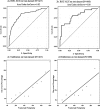A Computable Phenotype for Acute Respiratory Distress Syndrome Using Natural Language Processing and Machine Learning
- PMID: 30815053
- PMCID: PMC6371271
A Computable Phenotype for Acute Respiratory Distress Syndrome Using Natural Language Processing and Machine Learning
Abstract
Acute Respiratory Distress Syndrome (ARDS) is a syndrome of respiratory failure that may be identified using text from radiology reports. The objective of this study was to determine whether natural language processing (NLP) with machine learning performs better than a traditional keyword model for ARDS identification. Linguistic pre-processing of reports was performed and text features were inputs to machine learning classifiers tuned using 10-fold cross-validation on 80% of the sample size and tested in the remaining 20%. A cohort of 533 patients was evaluated, with a data corpus of 9,255 radiology reports. The traditional model had an accuracy of 67.3% (95% CI: 58.3-76.3) with a positive predictive value (PPV) of 41.7% (95% CI: 27.7-55.6). The best NLP model had an accuracy of 83.0% (95% CI: 75.9-90.2) with a PPV of 71.4% (95% CI: 52.1-90.8). A computable phenotype for ARDS with NLP may identify more cases than the traditional model.
Figures
References
-
- Bellani G, Laffey JG, Pham T, Fan E, Brochard L, Esteban A, Gattinoni L, van Haren F, Larsson A, McAuley DF, Ranieri M, Rubenfeld G, Thompson BT, Wrigge H, Slutsky AS, Pesenti A. Investigators LS and Group ET. Epidemiology, Patterns of Care, and Mortality for Patients With Acute Respiratory Distress Syndrome in intensive care units in 50 Countries. JAMA. 2016;315:788–800. - PubMed
-
- Ranieri VM, Rubenfeld GD, Thompson BT, Ferguson ND, Caldwell E, Fan E, Camporota L, Slutsky AS. Acute respiratory distress syndrome: the Berlin Definition. JAMA. 2012;307:2526–33. - PubMed
-
- Koenig HC, Finkel BB, Khalsa SS, Lanken PN, Prasad M, Urbani R, Fuchs BD. Performance of an automated electronic acute lung injury screening system in intensive care unit patients. Crit Care Med. 2011;39:98–104. - PubMed
MeSH terms
Grants and funding
LinkOut - more resources
Full Text Sources
Other Literature Sources


